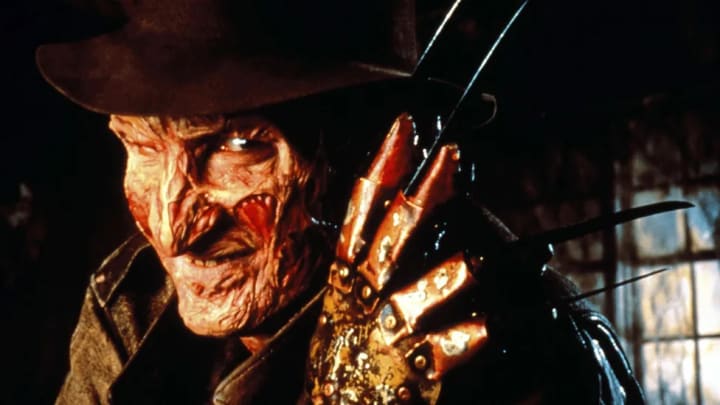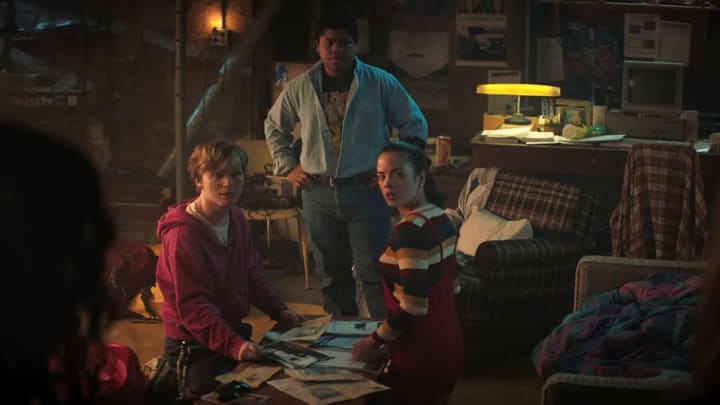
Different types of horror each have their fans, but perhaps there is no subgenre equally as beloved and derided as the slasher movie. The masked killer, the pile-up of dead bodies and the "final girl" are some of the most recognisable elements of a type of horror film that just refuses to die.
In fact, it may be ready for another resurgence. This Friday sees the release of the first instalment of Fear Street, a three-part film event which reinvents slasher tropes for a younger generation. Then later this year the original slasher series, Halloween, continues with Halloween Kills, while in 2022, the self-aware slasher movie franchise, Scream, is set to return with Scream 5, the first Scream film in more than a decade.

Horror has been evolving since the very beginning of cinema but the slasher stands out as a type of horror film that is governed by structure, and a set of rules that have become so recognisable they are often parodied.
Atlhough the slasher didn't experience its first peak period until the late 1970s, it arguably started with Alfred Hitchcock's Psycho (1960), which established some of the rules that slasher films would continue to abide by 70 years on. These include a focus on a mysterious, brutal killer motivated by a traumatic event, whose identity remains a mystery until the end, and for his victims, the fact that sex invariably equals death, and that you never go to investigate a dodgy situation alone.
Meanwhile, on the other side of the Atlantic in the 1960s and 1970s, the roots of the slasher were forming in Italian giallo cinema – which took inspiration from cheap Italian crime novels (whose covers were usually bright yellow, hence the term 'giallo', which translates to 'yellow') – and added gruesome murders and increased body counts. Directors like Mario Bava and Dario Argento combined the murder-mystery narrative structure of crime novels with hyper-stylised murders that were equally gruesome and gorgeous.
The slasher's breakout moment
But it wasn’t until 1978 that the slasher experienced its first Golden Age, with the release of Halloween. Although there were precursors, including Texas Chainsaw Massacre, about students who stumble onto a cannibal family, and Black Christmas, about an unseen killer terrorising a group of female students in their sorority house, both released in 1974, Halloween was the first fully formed, perfectly executed example of the genre. It pulled visually from giallo (the featureless mask that villain Michael Myers wears harkens back to Bava’s Blood and Black Lace and the film starts with the favoured giallo technique of a murder being committed from the killer’s point-of-view) while being directly inspired by Black Christmas. Halloween's director John Carpenter had had a conversation with Black Christmas's director Bob Clark, about what would happen in a hypothetical sequel to his film: "it would be the next year and the guy would have actually been caught, escape from a mental institution, go back to the house, and they would start all over again," Clark said.
The perfect slasher villain is unstoppable. You can behead him, you can blow him up, and he will keep coming back – Mike Muncer
Most importantly, Halloween was decisive in centring the slasher on the teenage experience, something that would become crucial for the genre going forward. This furnished the slasher both with an enthusiastic teen market, and with universally relatable characters whose everyday adolescent woes made the arrival of a masked murderer all the more disturbing.
With a script originally titled The Babysitter Murders, Halloween was central in cementing the slasher tropes that Psycho and giallo films had first introduced, while perfecting some newer ones, including with its heroine Laurie Strode (Jamie Lee Curtis), who the killer Myers becomes obsessed with.

Strode was the defining "final girl" – a term coined by scholar Carol J Clover in her seminal book on slasher films Men, Women and Chainsaws, which refers to the last woman standing in a slasher, who is usually a paragon of innocence, rejects sex and drugs, and is coded as somewhat androgynous. She is never the pretty cheerleader, more likely the cheerleader's friend, and is the character the audience, regardless of gender, empathises with the most. (Clover's key, groundbreaking argument, is that slashers actually encouraged male viewers to relate to women, rather than being inherently misogynistic, as had been assumed by critics before). In some slasher franchises, like Halloween, and later in Scream, "the final girl" is also the real protagonist of the films. Whilst for the villain, killing her becomes the mission, for her, survival is everything. Strode grows stronger in every new entry in a slasher franchise, eventually becoming a hyper-capable, hyper-aware force of protection for those around her, without that completely erasing the trauma of her ordeal.
In Myers, Halloween also established a blueprint for the slasher villain. Whilst the "final girl" is the relatable central character, it's the slasher's villain that typically becomes any franchise's icon. Their likeness is usually on the poster. Their name permeates the culture. They become Halloween costumes, Funko pops, stickers, t-shirts, tattoos. Mike Muncer, creator and host of the Evolution of Horror podcast, tells BBC Culture that the perfect slasher villain is "unstoppable. You can behead him, you can blow him up, and he will keep coming back". They preferably have to have a simple backstory (in Halloween, we barely find out anything about Myers, save for the fact that he was evil incarnate from a very early age, when we see him commit his first murder as a toddler). And they have to have an iconic look, which makes them instantly recognisable even to non-horror fans. So it is that Myers, the Friday the 13th films' Jason Voorhees, and Scream's ever-changing Ghostface have all had their distinctive masks, while A Nightmare on Elm Street's Freddy Krueger has his bladed glove. "[The looks] almost transcend even themselves," as Muncer points out.
The power of the slasher villain
Like all monsters of horror cinema, slasher villains are almost always manifestations of cultural fears. Whilst the original monsters of horror were supernatural creatures with a dramatic flair – like Count Dracula, the Wolfman, the Creature from the Black Lagoon or the Mummy – this new generation of slasher villains was relentless predators whose identity was secondary to their iconography. At the same time, though, the villains of the slasher are always human (or were once, anyway), and through them we understand the core theme of the slasher film: the cycle of trauma that, if left undealt with, can lead people to commit terrible deeds.
Mary Wild, creator of the Projections lecture series at London's Freud Museum and co-host of the Projections Podcast, both looking at cinema through a psychoanalytical lens, sees trauma as a defining characteristic of the slasher villain, even down to the use of the knife as a preferred murder weapon: "[when] they are stabbing other people, it's an externalised manifestation of their trauma, displacing their own pain and suffering on to somebody else," she tells BBC Culture. "It's definitely trauma-driven, something really unspoken and something that's become corrosively taboo."
Scream essentially posited the question: what would the characters do if they knew they were the characters in a slasher movie?
The knife-wielding, mask-wearing villains of the slasher have become contemporary boogeymen, infecting the cultural consciousness of the generation in which they originated, and then being revived and updated for new ones.
Halloween was a massive box-office success and a watershed cultural moment, creating a star and "scream queen" out of Jamie Lee Curtis, an instant icon in the mask-wearing Myers, and launching a decade of slasher films to come, each iterating the rules established by Psycho and finessed by Halloween. Building from that success, the 80s saw the beginning of extreme franchising of the slasher genre, with the villains, more than the victims or the final girls, becoming the genre's main attraction. So far, Michael Myers of Halloween has had 12 films (we’re not counting the Myers-free Halloween III: Season of the Witch here), Freddy Krueger of Nightmare on Elm Street seven films, and Jason Voorhees from Friday the 13th 12 instalments. Even Norman Bates, the original proto-slasher villain, got his own franchise in the 80s, which explored his mummy issues in depth, with Psycho II (1983), Psycho III (1986) and Psycho IV: The Beginning (1990). Sometimes, the power of villain recognition has transcended the films themselves (arguably the Friday the 13th movies are more recognisable as the "Jason movies").

But the excess of franchise entries, the tired rip-offs and the increasingly mediocre output dampened the quality of the slasher. The rules of the genre had become tired, mechanical, the characters were paper-thin, and the main attraction centred on the inventiveness of the murders.
Enter Scream (1996). Written by Kevin Williamson and directed by horror veteran and creator of Nightmare on Elm Street Wes Craven, Scream pushed forward a new era of slasher domination that lasted until the mid-2000s based on two key factors: it re-embraced the teen sensibility and appeal that had been so groundbreaking in Halloween; and it cheekily acknowledged the history of the genre. Scream essentially posited the question: what would the characters do if they knew they were the characters in a slasher movie?
With Scream, Craven, who had already attempted a somewhat less successful meta-horror with 1994's Nightmare on Elm Street film New Nightmare, launched a new era of slashers. New franchises like I Know What You Did Last Summer (1997) and Urban Legend (1998) were established, creating a new generation of "scream queens". Older properties were revamped and revisited, with Halloween H20 (1999), Texas Chainsaw Massacre: The Next Generation (1994), Bride of Chucky (1998) and even a shot-by-shot remake of Psycho (1998). The same pattern emerged: the genre revived with a burst of new, fresh energy and very quickly tired itself out by repeating the same formula.
The new era
But now, in 2021, it seems we might be ready for another iteration of the genre – one that, in Fear Street’s case, takes all of the elements that have now become clichés and bathes them not in irony like Scream, but instead in a distinctly millennial brand of nostalgia and earnestness.
Fear Street 1994, the first in the trilogy of films being released across three weeks in July on Netflix, is a throwback to the elements that make a slasher, with a supernatural twist. The first instalment in the trilogy starts off with a knowing wink to 90s nostalgia: a mall, a creepy phone call and a masked killer. However, unlike in the Scream films, the killer is unmasked straight away; their identity is not really the point. Based on the series of teen-oriented novels by RL Stine, the trilogy is set between the divided fictional towns of Sunnyvale and Shadyside, the latter dubbed the "Killer Capital USA" because of a history stained by gruesome murders. There's something sinister going on in the town that has to do with the twisted legacy of a woman, Sarah Feir, accused of witchcraft and hanged in the 17th Century. Shadyside has embraced this legacy (even the high-school football team is called the Shadyside Witches). In the first film, to the tune of a medley of alternative hits from 90s bands such as Nine Inch Nails, Pixies and the Cowboy Junkies, we meet our protagonists, all of them outsiders in one way or another: Shadysider Deena, an antagonistic band camp-going teen pining for her ex-girlfriend, closeted Sunnyvale cheerleader Sam, and Sam's brother Josh, who mainly hangs out in his basement and on AOL chat rooms.
It's sometimes frowned upon as an unsophisticated subgenre that is just naked violence, but there's something within the cinematic discourse that is compelling – Mary Wild
Where Fear Street 1994 succeeds is that in centering its story on the teenage experience, it nevertheless upends the traditional slasher by making the protagonists the type of teenagers that would've ordinarily got killed off in the first act, or serve only as side-kicks to the heteronormative, conventionally attractive protagonists. Deena, Sam and Josh wouldn't make it past the first act in a slasher, but here their traditional teenage fears about relationships, their parents and school are intertwined with the very real threat of not one, but multiple stab-happy murderers. Whereas the main characters of slasher films are usually the cheerleaders and jocks, perhaps with the aforementioned virtuous final girl and a token nerd thrown in, Fear Street 1994's central gang of protagonists include two queer women and a tecchy loner. Their refreshing dynamic brings the fun into what could otherwise be a self-serious slasher.

At the same time, the film embraces some of the knowingness of Scream, with Fear Street director Leigh Janiak, who grew up as a massive RL Stine fan, explicitly aping the stunt-casting of both Psycho (which cast and positioned Janet Leigh as the film's leading lady only to kill her off in the first half hour) and Scream (which disposed of Drew Barrymore, the film's most popular star, before the credits even rolled) with the casting of Maya Hawke, one of the stars of Stranger Things, Netflix's other major teen horror property. The opening sequence of Fear Street 1994 is a direct homage to Scream.
The question is: with Fear Street being positioned as the horror event of the summer, could it lead to another renaissance of the slasher genre?
Wild thinks there's an increase in goriness in contemporary slashers. "There is more time allotted to the violence, as opposed to it [merely] being the title event," she says. "It’s a prolonged, stretched out dedication to the slasher element," But it's this violence, arguably, that is both a reason some people look down on slashers and others keep coming back to them. "It's sometimes frowned upon as an unsophisticated subgenre that is just naked violence, but there's something within the cinematic discourse that is compelling. It's visually and narratively expressing something that's unspeakable. Maybe it's helping us process those really violent urges."
On a commercial level, the constant revisiting and reinventing of the genre can also be boiled down to these films' appeal with teenage and younger audiences, and that's precisely who Fear Street aims to capture. Slashers are Friday night movies. They're not full of existential dread. They won't make you question your place in the universe. They're fun scary films that teens dip into for a good time – "kind of similar to the drive-in movies of the 50s," says Muncer – and long-time horror fans can enjoy them for their familiar patterns whether they're revisiting an old franchise or exploring a new set of horrors.
Certainly, with a trilogy of films that centres teens, explores intergenerational trauma, and has enough references to keep horror fans busy for the entire month of July, Fear Street brings back a mixture of earnestness and fun, Friday-night energy to the slasher – at once returning it to its pre-ironic beginnings, and shaking the formula up enough to make it feel fresh again.
About the Creator
Wu Mu
Dreams are not limited, nothing can be achieved






Comments
There are no comments for this story
Be the first to respond and start the conversation.